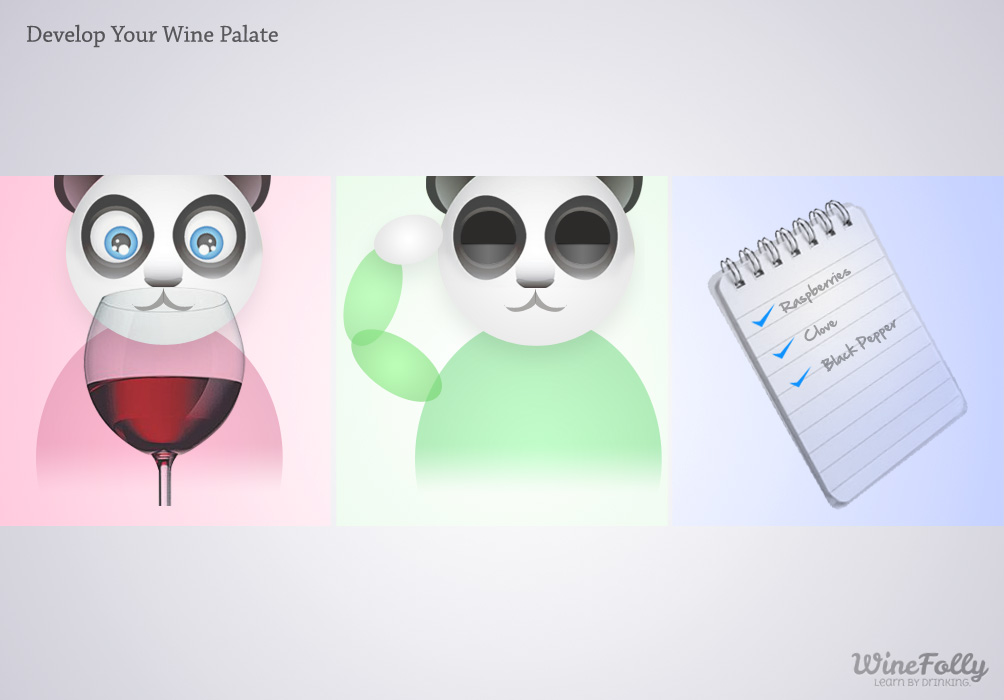
Develop Your Wine Palate
Have you ever tasted a wine and distinctly remember smelling fruit roll-up or perhaps 5-spice powder? You may have a naturally attuned wine palate that can be developed with 6 simple techniques.
Your palate is composed of a series of taste buds, tongue, the interior of your mouth and the most important sensor of all: your nose. Developing a good palate starts with paying close attention to what’s going on with these aforementioned sensory areas. If you want a truly remarkable palate, you’ll additionally need to take steps to protect and prime your palate. Priming, however, is a thought for another time. In the meantime, try the following 6 techniques to develop your wine palate.
- Slow Down
- Look and Smell. Then Taste.
- Visualize and Isolate Flavors
- Identify Flavors and Move On
- Pay Attention to Texture and Body
- Build a Wine Memory
Step 1: Take it Slow
Have you ever slowly savored a chocolate truffle? Rich ganache slowly melting on your tongue as the flavors evolve gradually throughout your mouth. This slow savoring where you let your senses take over is how you can bump up your skill at tasting wine. It takes time to determine the nuances of a wine and our own brains achieve a higher level of analytical thinking when we slow down.
Step 2: Look and Smell. Then Taste.
The look is not as important as the smell, however both play a large roll in our perception of a wine before it even touches our lips. You can test this theory by blindfolding a friend and giving them a room temperature white Rioja (a bolder white wine from Spain); you can trick them into thinking it’s a red wine. If you remove your nose from sensing a wine it’s very difficult to taste anything but the texture of a wine.
Step 3: Visualize and Isolate.
Sitting with my nose hovering over a glass with my eyes closed I suddenly start identifying the flavors of a wine faster than with my eyes open. I see roses, red cherries, a clay pot and cloves. The rose smell is less pronounced than the red cherry smell and when I close my eyes I imagine that the roses and cherries are in a terra cotta clay pot that’s been rubbed with baking spices. This must be a younger Chianti, a sangiovese from Italy made in a more modern style. By using visualization, I’m able to isolate flavors and paint a picture in my mind that resembles other pictures I’ve recalled when I’ve tried Chianti. This is how I place a wine in style and a region when I blind taste it. When you train your palate, tasting pinot noir is like tasting bacon… you just know it as soon as you smell it!
Step 4: Identify Flavors and Move On.
It’s easy to get held up on a flavor in a wine. I smelled a wine once and all I could smell was anise. I couldn’t get past the smell of anise and identify the wine. Once you identify a flavor or aroma, it’s useful to move past it and ask “what else is here.” The nuances are what make wines unique or particular to where they originate.
Step 5: Pay Attention to Texture and Body.
Fruit flavors in a wine aren’t the only flavors in a wine. Texture adds to the flavor and gives a wine body. For instance a viognier, a white wine, is known for having an oily texture in the middle of the tongue. Oftentimes I’ll rub my tongue on the roof of my mouth to identify features like minerality or tannin. Does the tannin hit you in the side of the mouth, the front or the middle?

Step 6: Build a Wine Tasting Memory.
Picking out the key points of a wine helps to build a taste memory. Your working wine memory is something you can use to refer to when tasting new wines and finding new favorites. For instance, many young Spanish grenaches I’ve tried have a ruby red grapefruit flavor and it helps me identify the wine in a blind tasting. Using taste memory can also help when thinking about food and wine pairings. Find out more about pairing food and wines.
As much as your memory is powerful on the fly, it’s useful to take notes about wines, especially during wine tastings.